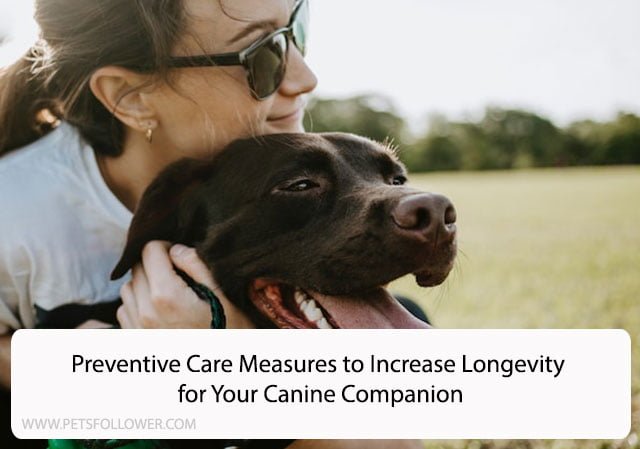
Raising a dog is an eye-opening experience as one gets loyalty and companionship from a furry friend. However, as your pet ages, you feel apprehensive about losing it. According to clinical data collected by an American pet hospital, the mean age at death for canines was 10.66 years, while the median age was 11.57 years.
The life expectancy of dogs depends on size and breed, so there is no one-size-fits-all number. Bobi, the oldest dog ever, was 31 years old at the time of its death early this year. No matter how long your canine companion lives, losing it is painful. While you cannot defy time and age, there are ways to extend your pet’s lifespan.
You only need to adopt a few preventive care measures from a young age. In this article, we will share a few measures to increase the lifespan of your dog.
Ensure Balanced Nutrition

A well-balanced and nutritious diet is essential for raising a healthy dog. PetMD recommends following the Association of American Feed Control Officials (AAFCO) to ensure balanced nutrition for your canine. These include feeding adequate amounts of carbohydrates (including fiber), vitamins, minerals, protein, fat, and water. The amounts may differ according to the breed, size, age, and health conditions.
Fortunately, you can find high-quality pet food products from reputable brands to provide balanced nutrition to your pet. The right nutrients and portions ensure good health and optimal weight, contributing to longevity. You can find an ideal product at a pet store, or avail of PetPlus membership to shop online and unlock discounts.
PetCareRx emphasizes that paying a membership fee is worthwhile because it enables you to buy top-quality pet food at a lower price. Moreover, you get the benefit of convenience with the delivery of supplies at your doorstep. You can focus on pet care instead of spending time shopping or worrying about the rising prices.
Create a Realistic Exercise Schedule

Regular physical activity is another preventive measure to ensure a longer lifespan for your dog. Research suggests that exercise is linked with fractional lifespan, gait speed, and memory in aging canines. Additionally, it prevents obesity, a key determinant of canine longevity. Over the years, several studies have established that obese and overweight dogs live less than lean ones.
Exercise also strengthens bones, boosts muscle tone, and improves mobility in senior dogs. You can incorporate age-appropriate exercise, stretching, and conditioning as early as possible in your pet’s routine.
At the same time, know your dog’s limits. You can’t expect an older dog to have the same level of stamina and athletic capabilities as it had when it was young. Encourage it to slow down but keep moving.
Plan Regular Vet Visits

Timely detection and treatment of diseases in dogs is another way to improve canine longevity. Ideally, you must plan a vet visit at least once a year. You will need to follow a bi-annual routine for a senior canine. However, pet owners often fall short due to a lack of time or resources.
According to statistics, mean annual expenditures on vet visits for one-dog homes in the US soared from $224 in 2020 to $362 in 2022. Set aside a budget or buy insurance to cover these costs, but do not miss out on regular checks.
During a vet exam, the specialist performs a thorough exam from nose to tail. Your canine will also get routine blood work examinations and preventive screening tests to ensure everything is functioning well. The vet can catch any abnormalities early, preventing them from becoming a significant problem or a life-threatening disease.
Expect recommendations for supplements and medications for a senior dog to keep it in top shape and address minor issues. Besides scheduled checks, take your pet to the clinic if something seems amiss, no matter how insignificant the issue appears.
Keep an Eye on Parasites

Parasites are a lesser-known threat to pets, but they can pose severe health issues if you let them thrive. Fleas and ticks are more common in some seasons, but they may live on your pet’s body throughout the year. Senior dogs have weakened immunity, making them prone to fleas, ticks, and worms. Keep a close eye on them between vet visits because they may go undetected if you do not pay attention.
Also, implement a preventive parasite control plan to keep them at bay. For example, deworming, heartworm prevention, and regular flea and tick treatments can save your canine companion from a lot of trouble. Discuss the treatment options with your vet and seek preventative guidance to address your dog’s specific needs and risks.
Pay Extra Attention to Aging Concerns

As your dog ages, several things change over time. Owners need to be vigilant about these changes and adapt their lifestyles and expectations accordingly. Here are a few changes you may notice as your pet approaches its golden years:
Mobility
Canine osteoarthritis is a common age-related issue, affecting almost 40% of dogs, even when they are young. Besides causing pain and inflammation, this condition can affect your pet’s mobility. Consider installing ramps to prevent falls for senior dogs. Wood floors can become risky for them to navigate, so cover them with inexpensive carpet runners. Timely supplementation can lower the risk of joint pains, inflammation, and mobility issues.
Hearing Loss
Older dogs may encounter hearing loss, making it risky to leave your pet outdoors alone. It may miss out on traffic sounds and get into trouble. You can avoid this safety risk by modifying your pet’s routine or environment.
Vision Loss
Vision loss is another age-related implication of canine aging. The decline is often slow, but it progresses over the years. Home modifications like preventing obstacles and keeping your furniture layout consistent can prevent mishaps.
Cognitive Issues
You may notice signs like longer sleep hours and trouble recognizing you or family members in your aging pet. These are indications of cognitive decline, an age-related phenomenon in humans. You may also notice higher levels of separation anxiety in your senior pet. Try activities to keep your dog’s mind active and spend quality time with it.
Summing up, canine longevity depends on how well you look after it during the early years. A preventive approach can keep health issues at bay and add to the lifespan of your pet. These actionable tips can keep your canine healthy while it is young and add years to its life in the long run.





